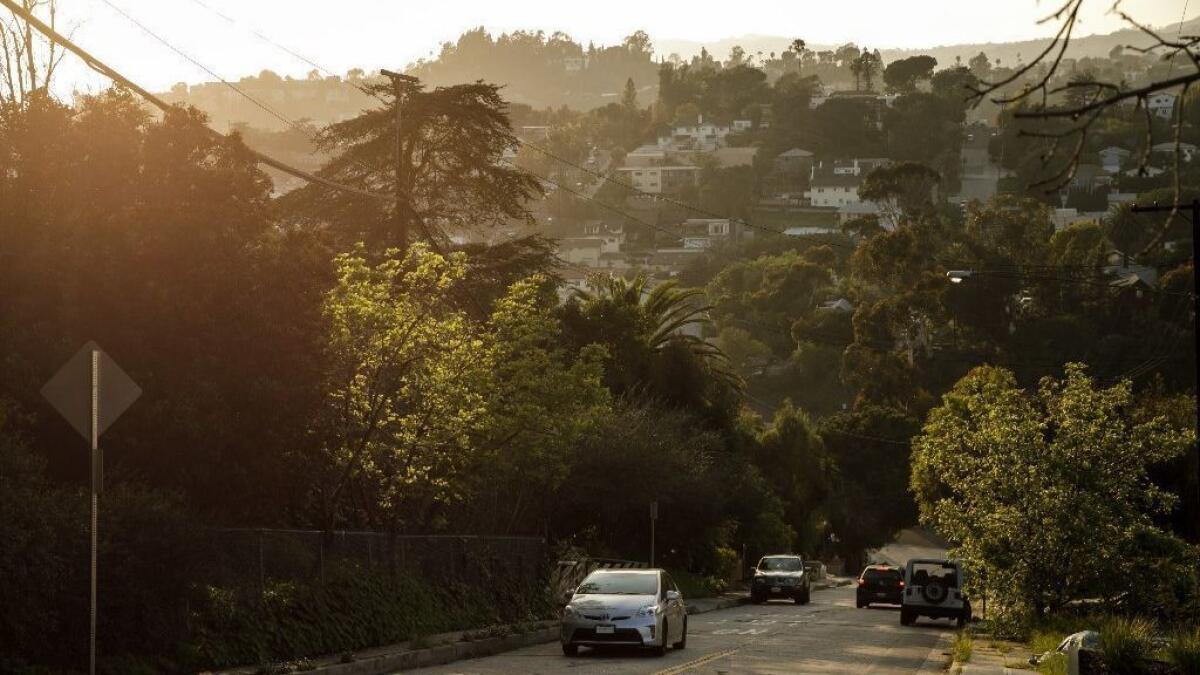Op-Ed: Neighborhood streets shouldn’t be speedways, but they shouldn’t be parking lots either

- Share via
Los Angeles is a city of neighborhoods, as much as it is one of sprawl. It’s also a city, indisputably, of bad traffic. When you combine many of our neighborhoods with cars, you get congestion in the form of drivers who don’t know how to navigate the narrow side streets that lattice Los Angeles between the major boulevards.
No matter the time of day, or even the day of the week, I face this complication where I live: Vehicles barreling down the center of a street that would be a tight squeeze even if they stayed on their side of the road. With parked cars lining both curbs, someone has to pull over and wait. It’s a tiresome game of chicken crossed with politesse.
I can’t help but think life would be easier if at least some of the city’s smaller, neighborhood streets — mine, for instance — were reconfigured as one-way.
This is not a new idea. In 2007, a study commissioned by then-Los Angeles County Supervisor Zev Yaroslavsky found that making Olympic and Pico boulevards one-way between downtown and Santa Monica could increase capacity on those streets by 20%. Admittedly, those aren’t neighborhood byways, they’re big thoroughfares, but the data show that one-way travel can improve efficiency. A 2008 Rand Corp. monograph called “Moving Los Angeles” concluded that “converting two-way streets to one-way operation can increase the effective vehicle capacity by as much as 50%.”
I believe in the city of the future, but until it arrives, one-way traffic might be an idea whose time has come again.
Just this year, the city converted two sections of steep Baxter Street in Echo Park to one-way traffic for safety reasons, in the face of “increased vehicular volume.” And yet, the conversation about the efficacy of one-way streets has changed considerably since Yaroslavsky’s study 11 years ago. These days, cities such as Louisville, Ky., have begun converting one-way streets back to two-way because in most instances two-way streets are slower and therefore safer, especially for pedestrians trying to get from curb to curb.
Besides, speed isn’t all that great for a city’s quality of life, says Michael Manville, associate professor of urban planning at UCLA: “We need to think about streets as more than conduits. They are multipurpose public spaces.”
Manville calls small neighborhood streets like mine “yield streets,” because cars must yield to other cars on them. He likes yield streets. They force the city to operate on a more human scale.
Such a view is in keeping with much contemporary thinking about urban landscapes and the way cities evolve. Planners envision future transportation as a mix of options that emphatically doesn’t favor individual drivers. Big boulevards with fewer car lanes and more room for bikes and buses or light rail, for pedestrians and even scooters. The idea is that there will be fewer cars because we will have more and better options.
Enter the Fray: First takes on the news of the minute from L.A. Times Opinion »
In 2017, Lyft, in conjunction with the San Francisco-based architectural firm Perkins+Will, offered a glimpse of what that might look like, imagining a redesign for Wilshire Boulevard between the 405 and UCLA. This is a heavy-traffic corridor, with a capacity that maxes out at around 30,000 people every hour. Lyft and Perkins+Will suggest that autonomous vehicles — buses running one after the other in quick succession — could raise that capacity to 77,000 people per hour.
In the meantime, I’m caught every day between a parked car and an oncoming one. We are still auto-centric in Los Angeles. Transit ridership is down, and single drivers stuck in traffic proliferate. The city of the future, the one we say we are building, remains, in many ways, a projection. One day, there will be a built-out mass transit system, autonomous vehicles and flying rideshare. But until then, what about my commute?
So I keep thinking about one-way streets, especially in the tight confines of older neighborhoods — Koreatown, Echo Park, mid-Wilshire, where I live. If traffic gets too efficient, too fast on my street (although that’s hard to imagine), there are ways to mitigate it, including more stop signs and speed bumps. This, at least, would do away with the games of chicken in which I participate most days.
I don’t want my street to be a speedway, but neither should it be a parking lot and obstacle course. I believe in the city of the future, but until it arrives, one-way traffic might be an idea whose time has come again.
David L. Ulin is a contributing writer to Opinion.
Follow the Opinion section on Twitter @latimesopinionand Facebook
More to Read
A cure for the common opinion
Get thought-provoking perspectives with our weekly newsletter.
You may occasionally receive promotional content from the Los Angeles Times.







